Articles and News
TALKING TRENDS: WHAT’S HOT NOW | September 13, 2011 (5 comments)
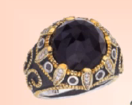
New York, NY—What makes a trend? Is it a conspiracy of designers all sitting in a cave, deciding what will be the “new black” of a season?
Not really, though it often feels that way. Trends, says Amber Michelle, editor-in-chief of Rapaport Magazine, are a reaction or an artistic expression of something we’re all experiencing.
A panel discussion at the 2011 Rapaport International Diamond Conference held here Monday homed in on the key trends in luxury jewelry design, including the what, the why, and what’s likely to be next. Michelle led a panel consisting of jewelry and style expert and red carpet commentator Michael O’Connor, Janet Goldman, founder and owner of Fragments designer jewelry showroom and retail store, Nina Runsdorf and Laura Aman, designers of New York-based NSR, Nina Runsdorf; and Kerri Halpern, designer of New York-based Madstone.
“What we’re all experiencing right now, of course, is the economy,” said Michelle of the pervasive sense of doom and gloom. There’s a sense that if one has it, don’t flaunt it—especially if one’s neighbor has been out of work for a long time.
“It’s a dark time, which leads to dark jewelry, and our first trend is black.” This trend includes both blackened metal and black diamonds.
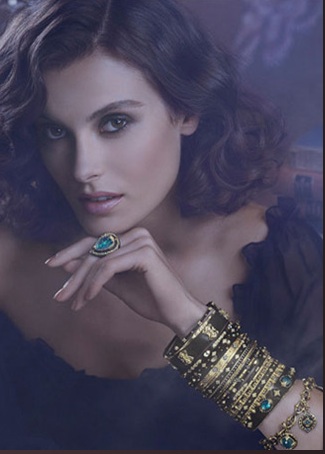
Blackened metals such as these bracelets by Emily Armenta, reflect the trend inspired by tough times.
“During tough times, people come back to classics, to the tried and true,” says Michelle. There’s nothing more classic than diamond, or than the combination of black and white in fashion, and now, in jewelry.
The second trend she outlined is “funky diamonds,” including slices, rough, rose cuts, opaque stones, and diamond beads created from material that previously would have been left for industrial goods. A funky black diamond ring shown top left was one of the ones Michelle used to illustrate her point.
The third trend is charms and amulets, with a top trend being initials—the ultimate in personalization—also a key motivator for Millennials. Initials aren’t new but they are when they’re done in an edgy way and piled on in multiples to represent family and friends.
“When times are tough, you want to keep your nearest and dearest close by,” said Michelle. Going hand in hand with that are amulets and symbols of faith, which people turn to in times of stress. Especially popular now are the Hamsa hand and Evil Eye, both of which have roots in Middle Eastern culture.

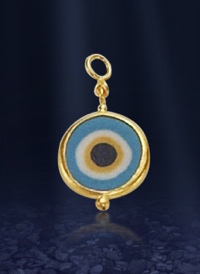
The Hamsa hand, left, and Evil Eye, right, are two popular amulet styles. Both are rooted in Middle Eastern culture and believed to protect the wearer from evil or harm. These examples both are executed in 18k gold, by Lika Behar.
Circles are trending again—a classic shape, but also representing the cycle of life and hope.
Color gemstones are trending because they have a happy, feel-good sense about them and, especially, in many cases are affordable—which increasingly, diamonds, gold, and platinum are not.
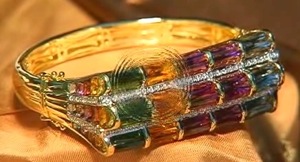
Bellarri's Venus collection incorporates happy colored gemstones.
Movement is important. Anything that moves appears bigger, said Michelle, a classic more-for-your-money technique. Among jewels with movement, tassels are particularly popular.
Finally, as we’ve been seeing since metals prices began climbing, openwork is important as a means of creating a big look with less metal.
Michael O’Connor echoed Michelle’s sense that color is here to stay. “It’s [New York] Fashion Week this week, and we’re seeing color all over the runways,” he said. This has been true for the past few seasons and shows no signs of letup.
Also on the runways, O’Connor is seeing a lot of volume in clothes. Cuts are bigger, fabrics are voluminous, and therefore jewelry has to be larger to keep up with the proportion and not be lost in the folds.
The third trend O’Connor feels is important is casualness. Not a new trend, he points out that our overall society is in a more casual place, which is why we’re seeing so much leather and feathers in jewelry and so many rough gems.
But no matter what the actual design trends are, O’Connor reminded the audience, “The consumer mindset is all about value. You have to frame all trends inside of that.”
Janet Goldman of Fragments said she’s seeing a dichotomy among her customers’ preferences: it’s either big bold jewels or “itsy-bitsy necklaces on chains.” And, of course, black.
“Customers want to know, ‘what’s new?’” she said. “How do we package it? We’re responsible for selling the trends.”
Laura Aman pointed out that sometimes it can take two to three years for a trend to catch on, such as the diamond slices she and Nina Runsdorf use in their jewelry. Runsdorf added that it’s right to incorporate organic and classic now.
Finally, Kerri Halpern of Madstone said she’s seeing so much ‘70s influence in fashion right now, that it inspired her to use lots of octagons—a very ‘70s shape—in her designs.
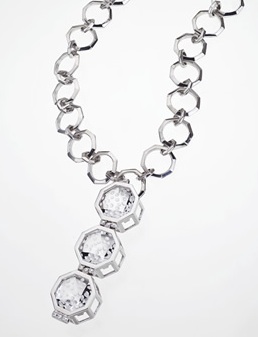
Madstone incorporates the octagon shape, popular in the 1970s, into modern jewelry.
“The one thing nobody mentioned in all our discussion about color, is the importance of colored gold,” she added.
The celebrity and fashion factor. Amber Michelle asked panelists, “How much of what’s worn on the [fashion] runway or red carpet really impacts what consumers want?”
The answer: a lot. It’s not just hype.
“If you think it doesn’t, you’re deceiving yourself,” said O’Connor. “The media took a huge hit [in revenue] during the recession, but celebrity media is the only category that’s growing.
“If everyone is doing long sleeves, bracelets are going to be less important. If everyone is doing high necks, necklaces are going to be less important. And right now, we’re seeing a lot of beaded gowns coming on, so that also means there won’t be a necklace [with it].
“Color and silhouette come right from the runway,” added Goldman. For example, lace is important in clothes—and in the cutwork patterns in jewelry.
“The fashionista wants the latest and greatest. The newest is on the runway and on celebrities, and it makes a female self purchaser feel good,” said Runsdorf.
Aman brought up a critical point: fashion has the runway for a venue to showcase what’s new and novel, but fine jewelry doesn’t have a venue. A tradeshow isn’t quite the same, she said.
“Is jewelry fashion?” asked Michelle.
“Yes, absolutely,” said Goldman. It’s self expression. Her assistant, for example, sees many of her peers getting tattoos, but she herself considers her jewelry to be her tattoo.
“Jewelry is the largest growth area for department stores,” said Aman. “Ready-to-wear has taken a back seat to stores like J. Crew and such, but not jewelry.”
Finally, Runsdorf identified the key difference between the runway and the red carpet: designers use the runway for promoting design—but the red carpet for promoting their brand.







